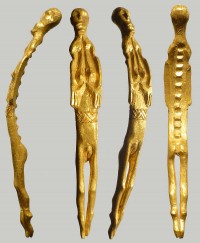 Three metal detector hobbyists scanning a field on the Danish island of Bornholm in early May discovered a stylized gold figurine of a nude woman. She’s a tiny thing, less than 1.7 inches high and weighing only three grams, but her maker managed to cram a great deal of detail in that small space.
Three metal detector hobbyists scanning a field on the Danish island of Bornholm in early May discovered a stylized gold figurine of a nude woman. She’s a tiny thing, less than 1.7 inches high and weighing only three grams, but her maker managed to cram a great deal of detail in that small space.
Her slim body is elongated and gently curved and may have been carved from a solid thin bar of gold. Her face is Modigliani long with a prominent jaw and strong features. Her hair is represented by striations carved into the back of her head and forehead. Her arms stretch down to her waist but just under the shoulders there are indents on both sides that may indicate her arms have been tied to her body. Her fingers point downwards, touching a belt carved in a zig-zag pattern, while her thumbs are outstretched horizontally towards each other, meeting underneath her sagging breasts. Her genitalia are unmistakable between slender, short but remarkably shapely legs with alternating curves of buttocks, knees, calves and elegantly pointed feet. When you look at her from the side, her legs make her seem like she’s jumping or on her tippie-toes.
The detail on her back is of particular interest because it’s never been seen before. The concave sway of her back is decorated with what archaeologists are calling “teeth.” They look more like steps to me. Since this is the first example of this design discovered, its significance is unclear.
Other gold figurines have been found in this field before. The first was found in 2009. She’s the fifth and the only female.
The five figurines were probably buried in the same place, individually or collectively, at some point during the 6th century AD, i.e. the Migration Period.
Three of them were found within five metres of each other, while the other two were found 10-15 metres further away. Presumably it was the plough that separated them.
This location may have been chosen due to the presence of one or more springs.
 Other artifacts, including figures made from cut and engraved gold sheets, have been found on the field. Believe it or not, the area has not yet been systematically excavated by archaeologists despite the very shiny incentive and the prospect of discovering more about a period that has very little in the way of documentary sources. Plans are in the works to rectify this.
Other artifacts, including figures made from cut and engraved gold sheets, have been found on the field. Believe it or not, the area has not yet been systematically excavated by archaeologists despite the very shiny incentive and the prospect of discovering more about a period that has very little in the way of documentary sources. Plans are in the works to rectify this.
Meanwhile, the four gold men and one gold woman are on display along with other treasures from Smørenge field at the Bornholm Museum.